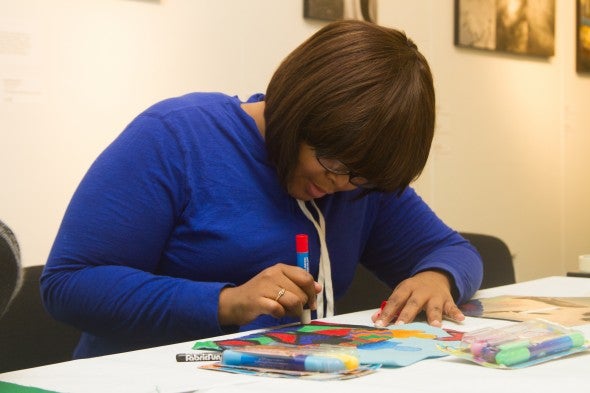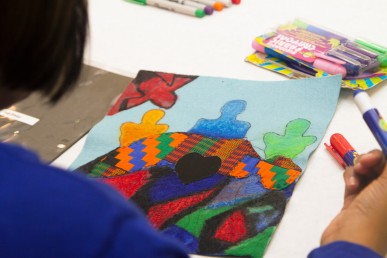Crafting a community

UIC community members are creating a quilt as part of a project sponsored by the Centers for Cultural Understanding and Social Change. (Photo: Vibhu S. Rangavasan)
In many communities, quilts served to offer warmth, protection and comfort from the cold but what many may not realize is that closely guarded secrets were often hidden in the patchwork pieces that made up the whole.
In the early African American tradition, quilts sometimes served to provide a hidden road map for slaves seeking freedom through the Underground Railroad.
And often, the practice of gathering to stitch together pieces of fabric served to create a community where people, often women, would join each other to talk, share ideas and seek comfort, said Lori Barcliff Baptista, director of the African-American Cultural Center at UIC.
More contemporary quilting practices include memory, keepsake and family tree quilts. Quilting communities and forums meet in person and communicate virtually to share patterns and support.
Barcliff Baptista said she tapped into that history as part of a year-long programing theme of the Centers for Cultural Understanding and Social Change to explore the word “remedy” as a way of bringing people together.
Since the beginning of the school year, more than a dozen students have attended drop-in sessions at the African-American Cultural Center in Addams Hall to work with Jim S. Smoote II, a Chicago textile artist and retired art teacher who is leading the sessions.
 “We wanted to think about ‘remedy’ with this summer being especially violent,” said Barcliff Baptista. “Instead of focusing on the negativity and the violence, we wanted to think about this language of self-care.”
“We wanted to think about ‘remedy’ with this summer being especially violent,” said Barcliff Baptista. “Instead of focusing on the negativity and the violence, we wanted to think about this language of self-care.”
Eventually, they hope to have enough pieces of the quilt produced by students to measure 14 feet by 6 feet. The aim is to have this quilt, along with others, to hang up in the center’s library.
Smoote said his job is to help students find their creative expression by using the themes of peace, unity and love. A quilt made by Smoote, which was inspired by President Barack Obama’s election victory, was featured at the DuSable Museum.
He said quilting is the perfect art form to bring people together and pointed to the tradition of creating “Friendship Quilts,” where people would gather to sew together pieces of cloth to create a large blanket for each member of the group.
He said getting people together to build a community where there is a discussion about what is happening in the world is important to accomplish change.
“You can get so numb from seeing it, so if you start a dialogue about what we can do individually to lessen it, that’s the point,” Smoote said.
Kapri Williams, a senior in applied psychology, has attended the sessions and is working on her portion of the quilt. Her portion shows an outline of a female figure breaking free of chains and appearing to float in the air.
Williams used black fabric with ingrained, intricate designs to fill in the outline of the figure. The figure has bracelets around her ankles with chains attached. The figure’s right leg still is shackled, and over chains reads the words, “lack of origin, police brutality, lack of resources, uneducated, oppression.”
“The things that help us to become free or self-aware is represented here, ‘love, pride, unity, family, cultural connections,’” she said as she pointed to words written over the other leg, where the chains have been shattered.
She is looking forward to the final product because she wants to leave a legacy of her time at UIC.
“Leaving a mark here on campus is really cool to think about,” Williams said. “Hopefully I can come back years from now with my kids, my grandkids and I can speak on it and reflect on these times.”
Leah Blocker, a senior in African American studies, said her panel depicts Africa as the homeland and as a mother and angel who is looking over and protecting people who have migrated throughout the world.
“If you just keep thinking about how far we came and how much we have to go, then you will always have that remedy and you won’t lose sight of what your purpose in life is,” Blocker said. “A quilt is a great way to show the message because it’s something you can pass down; it’s a great method to just keep this message of remedy forever going.”
